- 1 June 2023
- 313
Which Shoes Are Best for Avoiding Bunions?

As the prevalence of bunions continues to rise, many individuals are eager to find the perfect pair of shoes that will help them avoid this painful condition. From flats to flip-flops, there are countless options on the market, each claiming to be the best choice for foot health. But which shoes are truly the most bunion-friendly? Let’s explore the options and separate fact from fiction.
When it comes to selecting shoes that can potentially minimize the risk of developing bunions, several factors should be considered. Experts in the field of podiatry suggest that proper fit, ample toe room, arch support, and shock absorption are key features to look for.
Flats, with their wide toe boxes and minimal heel height, are often recommended as a bunion-friendly option. Dr. Sarah Thompson, a podiatrist specializing in foot conditions, explains, “Flats that provide adequate arch support and cushioning can be a good choice for those concerned about bunions. The wide toe boxes allow the toes to spread naturally, reducing pressure on the forefoot.”
However, it is important to note that not all flats are created equal. Flats with flimsy soles and no arch support may not provide the necessary protection and support for individuals prone to developing bunions. It is crucial to find flats that strike a balance between style and foot health, ensuring comfort without compromising on fashion.
Another popular choice during warmer months is flip-flops. Their open design and minimal material make them a go-to option for many individuals. However, flip-flops may not be the best choice for those concerned about bunions. Dr. Michael Adams, a podiatrist and researcher, cautions, “Flip-flops offer minimal support and stability, which can increase the risk of foot problems, including bunions. The lack of arch support and secure fit can lead to excessive strain on the feet.”
While flats and flip-flops have their pros and cons, athletic shoes often emerge as a reliable choice for individuals looking to avoid bunions. Athletic shoes typically offer ample cushioning, arch support, and shock absorption, making them a preferred option for those seeking comfort and foot health. Whether engaging in physical activity or simply going about daily tasks, athletic shoes can provide the necessary support to reduce pressure on the forefoot.
However, it is essential to choose athletic shoes that are appropriate for the intended activity and properly fitted. Ill-fitting or worn-out athletic shoes can lead to foot problems, including bunions. Regularly replacing athletic shoes and ensuring they provide adequate support is crucial for foot health.
In the pursuit of bunion-friendly shoes, it is important to remember that individual foot anatomy and needs vary. What works for one person may not work for another. Consulting with a podiatrist can provide valuable insights tailored to one’s specific foot structure and health concerns.
Ultimately, the best shoes for avoiding bunions combine proper fit, ample toe room, arch support, and shock absorption. Whether it’s flats, athletic shoes, or another style, the key is to find shoes that prioritize foot health without compromising on personal style.
As we navigate the world of footwear, it is important to remember that shoes alone cannot guarantee the prevention of bunions. Genetic factors, foot structure, and biomechanical abnormalities also play significant roles in their development. Taking a holistic approach to foot health, including regular exercise, maintaining a healthy weight, and seeking professional advice when needed, can contribute to overall foot well-being.
In conclusion, while there is no definitive answer to the question of which shoes are best for avoiding bunions, several factors should be considered. Flats with proper arch support and wide toe boxes, well-fitted and supportive athletic shoes, and a personalized approach to foot health can all contribute to minimizing the risk of developing bunions. By making informed choices and prioritizing foot health, individuals can stride towards a bunion-free future.

